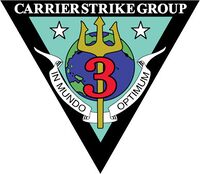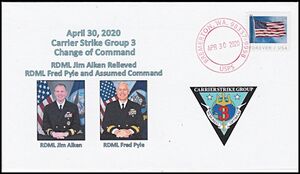OtherUS Carrier Strike Group Three
Cachets should be listed in chronological order based on earliest known usage. Use
the postmark date or best guess. This applies to add-on cachets as well.
CARRIER STRIKE GROUP THREE history
The aircraft carrier USS Wasp was assigned to Carrier Division Three from November 1940. In April 1941, a Central Atlantic Neutrality Patrol was established under Admiral A.B. Cook, based at Bermuda. It comprised Carrier Division Three, the cruisers USS Quincy and USS Vincennes, and Destroyer Squadron 11. On 7 December 1941, in the Atlantic Fleet, Carrier Division Three comprises USS Wasp and USS Ranger under Rear Admiral A.B. Cook. Commander Carrier Division Three served as Commander Task Force 77 during the Korean War. In 1966, Carrier Division Three was embarked aboard USS Enterprise flying missions in the Gulf of Tonkin off Vietnam.
On 30 June 1973, Carrier Division 3 was redesignated Carrier Group 3. US Navy carrier battle groups have, since the mid-Cold War period, maintained a pattern of deployments to trouble spots, beginning with an overhaul, individual ship training, battle group training, group preparation exercise, and then the deployment. On returning home, the cycle begins once more. As part of these deployments, the USS Carl Vinson carrier battle group participated in Exercise RIMPAC '84, RIMPAC '86, RIMPAC '98, PACEX '89, Exercise Rugged Nautilus, Operation Southern Watch, Operation Desert Strike, Operation Desert Fox, and Operation Iraqi Freedom. From 1989 to 1991, USS Carl Vinson served as the flagship for Carrier Group 3. During this period, Carrier Group 3 was one of three battle groups that took part in PACEX '89.
In August 1990, Commander, U.S. Seventh Fleet was deployed to Bahrain in order to serve as Commander, U.S. Naval Forces Central Command (ComUSNAVCENT) following the Iraqi invasion of Kuwait. Since ComUSNAVCENT operated from on board ship, he established NAVCENT-Riyadh as a staff organization to provide continuous Navy representation at United States Central Command headquarters. This mission was assigned initially to Commander, Carrier Group Three. During succeeding months, the NAVCENT-Riyadh staff was augmented substantially but remained small, relative to the United States Army Central and CENTAF staffs. In November, the NAVCENT-Riyadh command was transferred from COMCARGRU 3 to Commander, Cruiser-Destroyer Group 5. This change resulted in the Navy flag officer at NAVCENT Riyadh's remaining relatively junior to other Service representatives, particularly the Air Force.
In the middle of 1992, the U.S. Navy made some organizational changes. Each of the Navy's twelve carrier battle groups was planned to consist of an aircraft carrier; an embarked carrier air wing; cruiser, destroyer, and frigate units; and two nuclear-powered attack submarines.
From June 1993, Commander Carrier Group 3 had his flag aboard Abraham Lincoln. In 1993, the battle group provided support to the multinational military forces assigned to Operation Restore Hope in Somalia, and the group subsequently made three Western Pacific/Persian Gulf deployments for Operation Southern Watch and Operation Vigilant Sentinel. On 13 May 1997 Carrier Air Wing Eleven was reassigned to Commander, Carrier Group 3 and the USS Carl Vinson.
Carrier Group 3 formed the core of the naval power during the initial phase of Operation Enduring Freedom in 2001. At the time the group comprised USS Carl Vinson (CVN-70), Destroyer Squadron 9 and Carrier Air Wing Eleven. Commander, Carrier Group 3, Rear Admiral Thomas E. Zelibor, arrived in the Arabian Sea on 12 September 2001 and was subsequently designated Commander Task Force 50 (CTF 50), commanding multiple carrier task groups and coalition forces. The Task Force conducted strikes against Al Quida and Taliban forces in Afghanistan. Task Force 50 comprised over 59 ships from six nations including six aircraft carriers, stretching over 800 nautical miles.
Rear Admiral Evan M. Chanik was the last commander of Carrier Group 3. During his tenure, Admiral Chanik led the group through a reorganized Inter-Deployment Training Cycle which greatly compressed the training required for overseas deployment. On 1 October 2004, Carrier Group Three was redesignated as Carrier Strike Group Three.
| Thumbnail Link To Cachet Close-Up Image | Thumbnail Link To Full Cover Front Image | Thumbnail Link To Postmark or Back Image | Postmark Date Postmark Type Killer Bar Text Ship --------- Category |
|---|
|
N/A |
 |
N/A |
2004-10-01 |
|
Unit Logo |
In Mundo Optimum - The Best in the World
|
N/A |
 |
N/A |
2020-04-30 |
|
Change of Command |
Cachet by Neal J. Mills
If you have images to add to this page, then either contact the Curator or edit this page yourself and add them. See Editing Cachet Maker Pages for detailed information on editing this page.
Copyright 2024 Naval Cover Museum